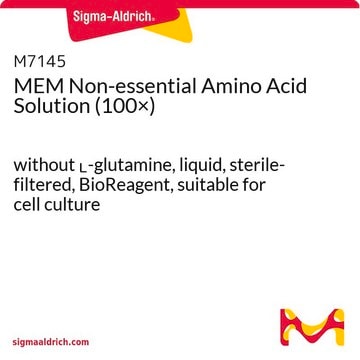Product 86012803, MCF7 Cell Line human, is not tested with RPMI. The recommended Culture Medium is EMEM (EBSS) + 2mM Glutamine + 1% Non Essential Amino Acids NEAA + 10% Foetal Bovine Serum FBS / FCS.
MCF7 Cell Line human
86012803, human breast (adenocarcinoma), Epithelial-like
Synonym(e):
IBMF-7 Cells, MCF7 Cells, Michigan Cancer Foundation-7 Cells, ssMCF-7 Cells
About This Item
Empfohlene Produkte
Produktbezeichnung
MCF7 Cell Line human, from human breast(adenocarcinoma), 86012803
Biologische Quelle
human breast (adenocarcinoma)
Wachstumsmodus
Adherent
Karyotyp
2n = 46, hypertriploid to hypotetraploid
Morphologie
Epithelial-like
Produkte
Not specified
Rezeptoren
Reported to express the oestrogen and progesterone receptor
Methode(n)
cell culture | mammalian: suitable
Relevante Krankheit(en)
cancer
Versandbedingung
dry ice
Lagertemp.
−196°C
Ursprung der Zelllinie
Beschreibung der Zelllinie
Anwendung
DNA-Profil
Amelogenin: X
CSF1PO: 10
D13S317: 11
D16S539: 11,12
D5S818: 11,12
D7S820: 8,9
THO1: 6
TPOX: 9,12
vWA: 14,15
Nährmedium
Subkultur-Routine
Sonstige Hinweise
Ähnliches Produkt
Hier finden Sie alle aktuellen Versionen:
Analysenzertifikate (COA)
Leider sind derzeit keine COAs für dieses Produkt online verfügbar.
Wenn Sie Hilfe benötigen, wenden Sie sich bitte an Kundensupport
Besitzen Sie dieses Produkt bereits?
In der Dokumentenbibliothek finden Sie die Dokumentation zu den Produkten, die Sie kürzlich erworben haben.
Artikel
Learn how to quantify spheroid formation, roundness, and circularity. Discover Millicell® Ultra-low Attachment plates, an ideal 3D cell culture model for uniform spheroid formation.
Learn about the similarities and differences in spheroid formation, roundness, and circularity between Millicell® ultra-low attachment plates and other ULA plates.
Verwandter Inhalt
Millicell® Ultra-low Attachment plates facilitate 3D cell culture with detailed application information for cell seeding to analysis.
-
Does this grow on RPMI? If so, what additional supplements does it need? If not, what recommended medium to be used to culture these cells?
1 Antwort-
Hilfreich?
-
-
How many Cell Line cells are in the vial?
1 Antwort-
Each vial of cells contains 2-3 x 106 cells in 1 ml of freezing media. This is in a 1.8 mL ampule. For exceptionally large cells, counts may decrease. Suspension cells, generally smaller cells, may contain as many as 4-5 x 106 cells/vial to assure optimal viability upon thaw.
Hilfreich?
-
-
How do I handle Cell Line frozen cells upon arrival?
1 Antwort-
Upon receipt, frozen ampules should be transferred directly to vapor phase liquid nitrogen without delay (-135°C) or liquid phase liquid nitrogen if vapor phase is not available. DO NOT use a -80°C freezer as an alternative; this will result in loss of viability.
Hilfreich?
-
-
Are my Cell Line cells mycoplasma tested?
1 Antwort-
ECACC routinely tests all manufactured cell banks for mycoplasma.
Hilfreich?
-
-
Are the Cell Line cells tested for viral pathogens?
1 Antwort-
HPA Cultures does not perform any viral testing on the cell lines.
Hilfreich?
-
-
What medium should I use when I thaw the Cell Line cells?
1 Antwort-
The medium for each cell line is listed on the product page. It is specific to each cell line. If not visible on the Sigma-Aldrich website product page, the HPA website also contains the same information (www.hpacultures.org.uk). The product number for the cell line is the same on either site.
Hilfreich?
-
-
Why is Vapor Phase Liquid Nitrogen preferred for storage of Cell Line cells?
1 Antwort-
If ampules are immersed into liquid phase of liquid nitrogen, it increases the risk of the liquid seeping into the vial. This could lead to problems of cross-contamination and increased risk of the ampule exploding when thawed.
Hilfreich?
-
-
What passage are my Cell Line cells?
1 Antwort-
If the passage of the cells is known, it is listed on the product page at the HPA website (www.hpacultures.org.uk).
Hilfreich?
-
Aktive Filter
Unser Team von Wissenschaftlern verfügt über Erfahrung in allen Forschungsbereichen einschließlich Life Science, Materialwissenschaften, chemischer Synthese, Chromatographie, Analytik und vielen mehr..
Setzen Sie sich mit dem technischen Dienst in Verbindung.







